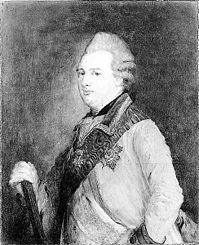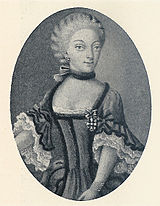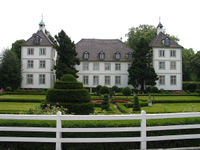- Prince Charles of Hesse-Kassel
-
Charles 
Charles of Hesse Spouse Princess Louise of Denmark Issue Marie Sophie, Queen of Denmark and Norway
Wilhelm, Prince of Hesse
Prince Frederik of Hesse
Juliane, Princess of Hesse
Prince Christian of Hesse
Louise Caroline, Duchess of Schleswig-Holstein-Sonderburg-GlücksburgHouse House of Hesse Father Frederick II, Landgrave of Hesse-Kassel Mother Princess Mary of Great Britain Born 19 December 1744
Kassel, HesseDied 17 August 1836 (aged 91)
Louisenlund, SchleswigBurial Schleswig Cathedral Charles of Hesse (Danish: Carl af Hessen-Kassel; German: Karl von Hessen-Kassel) (Kassel, 19 December 1744 – Louisenlund, 17 August 1836) was a cadet member of the house of Hesse-Kassel and a Danish general field marshal. Brought up with relatives at the Danish court, he spent most of his life in Denmark, serving as royal governor of the twin duchies of Schleswig-Holstein from 1769 to 1836.
Contents
Early life
Charles was born in Kassel on 19 December 1744 as the second surviving son of Hesse-Kassel's then hereditary prince, the future Frederick II, Landgrave of Hesse-Kassel (or Hesse-Cassel) and his first wife Princess Mary of Great Britain. His mother was a daughter of King George II of Great Britain and Caroline of Ansbach and a sister of Queen Louise of Denmark.
His father, the future landgrave (who reigned from 1760 and died in 1785), left the family in 1747 and converted to Catholicism in 1749. In 1755 he formally ended the marriage with Mary. The grandfather, William VIII, Landgrave of Hesse, granted the county of Hanau and its revenues to Mary and her sons.
The young Prince Charles and his two brothers William and Frederick were raised by their mother, and fostered by Protestant relatives since 1747.
In 1756, Mary moved to Denmark, to take care of the underage children of her sister, Queen Louise of Denmark, who had died in 1751. With her, she took her sons who were raised at the royal court at Christiansborg Palace in Copenhagen. The Hessian princes later remained in Denmark, becoming its important lords and royal functionaries. Only the eldest brother William returned to Hesse, in 1785, upon ascending the landgraviate.
Early career
Charles began a military career in Denmark. In 1758 he was appointed colonel, at the age of 20 major general and in 1765 was put in charge of the artillery. After his cousin, King Christian VII, acceded to the throne in 1766, he was appointed lieutenant general, commander of the Royal Guard, knight of the Order of the Elephant and member of the Privy Council. Also in 1766, he was appointed Governor-General of Norway, a position he held until 1768 but which remained mostly titular, as he never went to Norway during this period.
In 1763, his elder brother William married their first cousin, Danish Princess Caroline. Charles followed suit on 30 August 1766 at Christiansborg Palace — his wife was Louise of Denmark, and Charles thus became brother-in-law to his cousin, King Christian VII. The marriage took place despite advice given against it, due to many accusations of debauchery by Prince Charles and the poor influence he had on the King.
Shortly after, Charles fell into disfavour at court, and in early 1767 he and Louise left Copenhagen to live with his mother in the county of Hanau. They would have their first child, Marie Sophie, there in 1767 and then their second child, William, in 1769.
In 1768, Charles purchased the landed property and village of Offenbach-Rumpenheim from the Edelsheim family. In 1771 he had the manor expanded into a castle and princely seat. His mother Mary lived in the palace until her death in 1772. In 1781, Charles sold the Rumpenheim Palace to his younger brother, Frederick.
Governor of Schleswig-Holstein
In 1769, Prince Charles of Hesse was appointed royal Governor of the twin duchies of Schleswig and Holstein on behalf of the government of his brother-in-law, King Christian VII of Denmark and Norway. Charles took up residence at Gottorp Castle in Schleswig with his family. They would have their third child Frederick there in 1771.
In 1770, King Christian VII gave his sister the estate of Tegelhof in Güby between the City of Schleswig and Eckernförde. From 1772 to 1776, Charles had a summer residence constructed on the site which he named Louisenlund in honour of his wife.
In September 1772, Charles was appointed commander-in-chief of the Norwegian army and he and Louise moved to Christiana. The assignement was a consequence of the coup d'état of King Gustav III of Sweden on 19 August 1772 and the subsequent prospect of war with Sweden. While in Norway, Princess Louise gave birth to their fourth child Juliane in 1773. Even though Charles returned to Schleswig-Holstein in 1774, he continued to function as commander-in-chief of the Norwegian army until 1814. At the time of his return from Norway, he was appointed field marshal.
During the War of the Bavarian Succession in 1778-79, he acted as a volunteer in the army of Frederick the Great and gained the trust of the Prussian king. Once, when Frederick was speaking against Christianity, he noticed a lack of sympathy of Charles' part. In response to an inquiry from the king, Charles said, "Sire, I am not more sure of having the honour of seeing you, than I am that Jesus Christ existed and died for us as our Saviour on the cross." After a moment of surprised silence, Frederick declared, "You are the first man who has ever declared such a belief in my hearing."[1]
In 1788, the Swedish attack on Russia during the Russo Swedish War forced Denmark-Norway to declare war on Sweden in accordance with its 1773 treaty obligations to Russia. Prince Charles was put in command of a Norwegian army which briefly invaded Sweden through Bohuslän and won the Battle of Kvistrum Bridge. The army was closing in on Gothenburg, when peace was signed on July 9, 1789 following the diplomatic intervention of Great Britain and Prussia, bringing this socalled Lingonberry War to an end. On the 12th of November, the Norwegian army retreated back to Norway. During the retreat, the Danish-Norwegian army lost 1,500-3,000 men to hunger, disease, poor sanitary conditions, and exposure to continual autumn rainfall. Prince Charles was later criticised for his direction of the campaign and although he continued to function as commander-in-chief, he had lost his popularity in Norway.
When the crown prince and regent of Denmark, the future Frederick VI married Charles's eldest daughter Marie Sophie in 1790, he made several unsuccessful attempts at substantially influencing decisions of the government and the regent.
Charles was a remarkable patron of theater and opera. He had his own court theater in Schleswig, and he involved himself extensively in its operations.
During the Napoleonic Wars, he was in command of the army which briefly occupied Hamburg and Lübeck in 1801.
On 25 January 1805, Charles was granted the title "Landgrave of Hesse" by his elder brother, who had assumed the higher dignity and titulary of Imperial Prince-Elector.
In 1807, the manor and village of Gereby by the Schlei near Kappeln in Schwansen was renamed Carlsburg in honour of Prince Charles. Charles had purchased the property of Gereby in 1785, where he abolished serfdom in 1790.
Following the death of his distant relative, Friedrich Wilhelm von Hessenstein, he inherited the estate of Panker in Holstein in 1808.
In 1814 he was appointed general field marshal, and in 1816 Grand Commander of the Order of the Dannebrog.
Princess Louise died at Gottorp Castle on January 12, 1831. Prince Charles died on 17 August 1836 in castle Louisenlund in Güby, Schleswig.
Marriage and issue
On 30 August 1766 at Christiansborg Palace in Copenhagen, Charles married Princess Louise of Denmark, his first cousin, the youngest daughter of his aunt, Princess Louise of Great Britain, and King Frederick V of Denmark and Norway, who died the same year. The couple had the following children:
- Marie Sophie, Princess of Hesse (20 October 1767 – 21 March 1852), married on 31 July 1790 her first cousin the future King Frederick VI of Denmark and Norway
- Wilhelm, Prince of Hesse (15 January 1769 – 14 July 1772)
- Prince Frederik of Hesse (24 May 1771 – 24 February 1845), a general, married only morganatically Klara von Brockdorff. He was a Danish general and royal governor.
- Juliane, Princess of Hesse (19 January 1773 – 11 March 1860), Protestant Abbess of Itzehoe
- Prince Christian of Hesse (14 August 1776 – 14 November 1814)
- Louise Caroline, Princess of Hesse (28 September 1789 – 13 March 1867), married on 28 January 1810 Wilhelm, Duke of Glücksburg
Ancestry
Ancestors of Prince Charles of Hesse-Kassel 16. Wilhelm VI of Hesse-Kassel 8. Charles I, Landgrave of Hesse-Kassel 17. Hedwig Sophia of Brandenburg 4. William VIII, Landgrave of Hesse-Kassel 18. Jacob Kettler, Duke of Courland 9. Maria Amalia of Courland 19. Louise Charlotte of Brandenburg 2. Frederick II, Landgrave of Hesse 20. Maurice, Duke of Saxe-Zeitz 10. Maurice Wilhelm, Duke of Saxe-Zeitz 21. Dorothea Marie of Saxe-Weimar 5. Dorothea Wilhelmine of Saxe-Zeitz 22. Frederick William, Elector of Brandenburg 11. Marie Amalie of Brandenburg 23. Sophie Dorothea of Holstein-Glücksburg 1. Landgrave Charles of Hesse-Cassel 24. Ernest Augustus, Elector of Hanover 12. George I of Great Britain 25. Sophia, Countess Palatine of Simmern 6. George II of Great Britain 26. George William, Duke of Brunswick-Lüneburg 13. Sophia Dorothea of Celle 27. Eleonore d'Esmier d'Olbreuse 3. Princess Mary of Great Britain 28. Albert V, Margrave of Brandenburg-Ansbach 14. Johann Friedrich, Margrave of Brandenburg-Ansbach 29. Sophia Margaret of Oettingen-Oettingen 7. Caroline of Brandenburg-Ansbach 30. John George I, Duke of Saxe-Eisenach 15. Eleanor Erdmuthe Louise of Saxe-Eisenach 31. Johannetta of Sayn-Wittgenstein References
- ^ Murray, Iain (2000). Evangelicalism Divided : A Record of Crucial Change in the Years 1950 to 2000. Edinburgh: Banner of Truth Trust. p. 5.
- Biography in Dansk Biografisk Leksikon 1. ed.
External links
- Landgravial House of Hesse-Kassel
- Royal House of Denmark
- working lodge found by Prince Charles of Hesse-Kassel
3rd generation Prince Frederik* · Prince Christian* · William II* · Prince William* · Prince Charles Frederick* · Prince Frederick William* · Prince Louis Charles* · Prince George Charles*4th generation 5th generation Prince William · Frederick William, Landgrave of Hesse · Alexander Frederick, Landgrave of Hesse · Väinö I, King-Elect of Finland6th generation Prince Friedrich Wilhelm · Prince Maximilian · Philipp, Landgrave of Hesse · Wolfgang, Crown Prince of Finland · Prince Christoph · Prince Richard7th generation Moritz, Landgrave of Hesse · Prince Heinrich · Prince Otto Adolf · Prince Karl Adolf · Prince Rainer8th generation 9th generation Prince Moritz · Prince Tito* prince and landgrave of Hesse-Kassel until 1803Governors-general of Norway appointed by the Danish crown • 1572 - 1577 Pouel Ottesen Huitfeldt • 1577 - 1583 Ludvig Ludvigsson Munk til Norlund • 1583 - 1588 Ove Juel • 1588 - 1601 Aksel Gyldenstjerne • 1601 - 1608 Jørgen Friis • 1608 - 1618 Enevold Kruse • 1618 - 1629 Jens Hermansson Juel • 1629 - 1642 Christopher Knudsson Urne • 1642 - 1651 Hannibal Sehested • 1651 - 1655 Gregers Krabbe • 1656 - 1661 Nils Trolle • 1661 - 1664 Iver Tageson Krabbe • 1664 - 1699 Ulrik Frederik Gyldenløve, Count of Laurvig • 1669 - 1675 Ove Juel (Vice Governor) • 1675 - 1682 Jens Juel (Vice Governor) • 1682 - 1694 Just Högh til Fultofte (Vice Governor) • 1699 - 1708 Frederik Gabel • 1708 - 1710 Johan Vibe • 1710 - 1712 Ulrik Frederik Valdemar, baron Løvendal • 1712 - 1713 Claus Henrik Vieregg • 1713 - 1722 Frederik Krag • 1722 - 1731 Ditlev Vibe • 1731 - 1733 Patroclus Rømeling • 1733 - 1739 Christian greve Rantzau • 1739 -1750 Hans Jakob Arnold (acting) • 1750 - 1771 Jacob von Benzon • 1766 - 1768 Landgrave Charles of Hesse-Kassel • 1771 - 1809 Vacant • 1809 -1810 Christian von Schleswig-Holstein-Sonderburg- Augustenburg • 1810 -1813 Friedrich Landgraf zu Hessen-Kassel • 1813 - 1814 Christian Frederik af Danmark •Categories:- 1744 births
- 1836 deaths
- House of Hesse-Kassel
- Governors-general of Norway
- Grand Commanders of the Order of the Dannebrog
- Illuminati members
Wikimedia Foundation. 2010.







